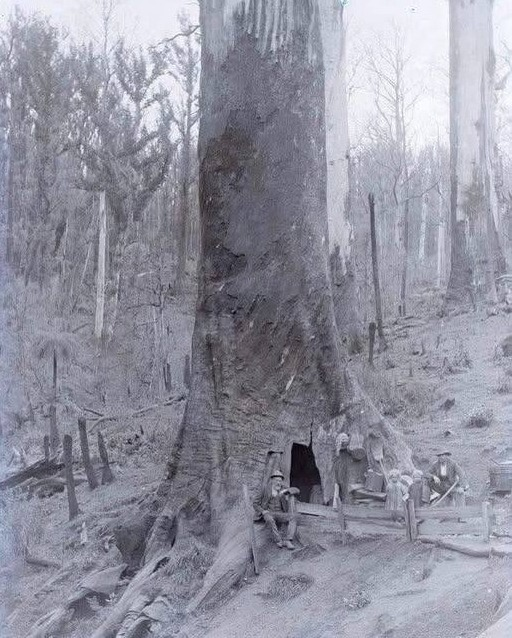In the 1870s, a daring family in Northern California made a singular decision — to live inside a hollowed giant tree
Picture the rugged wilderness of Northern California in the 1870s: dense forests of redwoods and sequoias, impenetrable underbrush, and the distant echoes of rivers carving through unspoiled land. The frontier was still raw and wild — many regions lacked even simple roads, much less comfortable housing. For pioneers arriving into this unforgiving terrain, survival demanded innovation, grit, and sometimes a willingness to blur the line between nature and refuge.
Against this backdrop, one family stood out: they made the extraordinary choice to turn a massive hollowed-out tree trunk into their home. Yes — they carved out a living space inside the heart of a giant tree.
Why would anyone do that?
It may sound like a fanciful myth, but their decision was rooted in practical necessity. The remote forest land offered scant access to milled lumber, nails, shingles, or even the manpower to haul materials long distances. Importing building supplies was costly and slow. Meanwhile, early settlers had to contend with the elements — bitter winters, fierce storms, sweltering summers, and the constant threat of wildlife.
In that environment, a hollow sequoia or redwood provided a ready-made shell: thick wood offering insulation, protection from wind and rain, and a structural form already shaped by nature. By clearing and shaping the interior, the family could convert it into a habitable living space, using the massive girth of the tree itself as walls.

The inside-out home: how it might have looked
Inside, they likely cleared out the core, removing rot, debris, and any decayed wood. Floors might have been built across natural cavities, using beams or branches. Light could enter through apertures or windows cut into upper trunks or side walls. Smoke outlets would be carved upward to vent cooking fires. The curved walls of wood would become both walls and ceiling. In effect, nature became their architect.
Furnishings would have been minimal and made from what the land offered: rough plank boards, tree stumps serving as seating, and rudimentary shelving carved into the trunk walls. Surrounding the tree, modest outbuildings—such as small sheds or lean-tos—might have been added for storage or livestock. The trunk-home likely operated not as their permanent forever-home, but as a shelter strong enough to tide them through the hardships of frontier life.
What it symbolized: resilience, ingenuity, and frontier spirit
This radical decision speaks volumes about the mindset of early settlers. It reflects a willingness to bend circumstances to survival, to think outside conventional shelter norms, and to use the land’s own strengths to one’s advantage. That a family would live inside a tree is poetic — nature and human life merged.
Beyond the functional logic, the image of a family dwelling within a tree became part of frontier lore. It embodied adaptability in its purest form. Those early settlers did not passively accept hardship; they confronted it with creativity. The hollow tree became a symbol for the gritty ingenuity that helped shape the American West.